A judge for all seasons and all women was only the second woman Justice of the US Supreme Court. A woman of indomitable courage and conviction, she stuck to her values against all odds, even at times taking up cudgels for men. But finding a woman judge of her stature and fearlessness in India is difficult as a Ruth Ginsburg can only emerge in a society governed by the rule of law where all institutions, including the press and the judiciary, do their assigned function without “fear or favour”, writes INDIRA JAISING.
———-
RUTH Bader Ginsburg, RBG as she was known, has passed on. At 84, she said that she was amazed that people wanted to take pictures with her. This coded remark probably sought to undo several stereotypes–that only young, blond woman are attractive and that age was a disability in public life. RBG was capable of disarming anyone in a quiet way and was capable of subverting the status quo from within the status quo.
Perhaps that is the reason she made it to the Supreme Court of the United States of America. She was not exactly President Bill Clinton’s first choice, since feminists were known to criticise her for her reservations on the role of the Court in Roe versus Wade. What weighed with him, after an extended interview, was his conclusion that she would be a “consensus builder”.
I would argue that building a consensus for women is a necessity and comes naturally to all of them. It is, therefore, no accident that she chose to do that early on in her career as judge in the US Court of Appeals for the District of Columbia. In 1980, US Democratic President Jimmy Carter appointed Ginsburg to the US Court of Appeals for the District of Columbia Circuit in Washington, D.C.
Strict Scrutiny
RBG must be seen as a woman of exceptional courage. She took an early decision to go against the tide of mainstream opinion and chart a path to success. She also chose the path of freedom and equality for all women. As a lawyer, this meant her finding a strategy to deal with a Constitution which had no guarantee of non-discrimination based on sex, nor of equality for women.
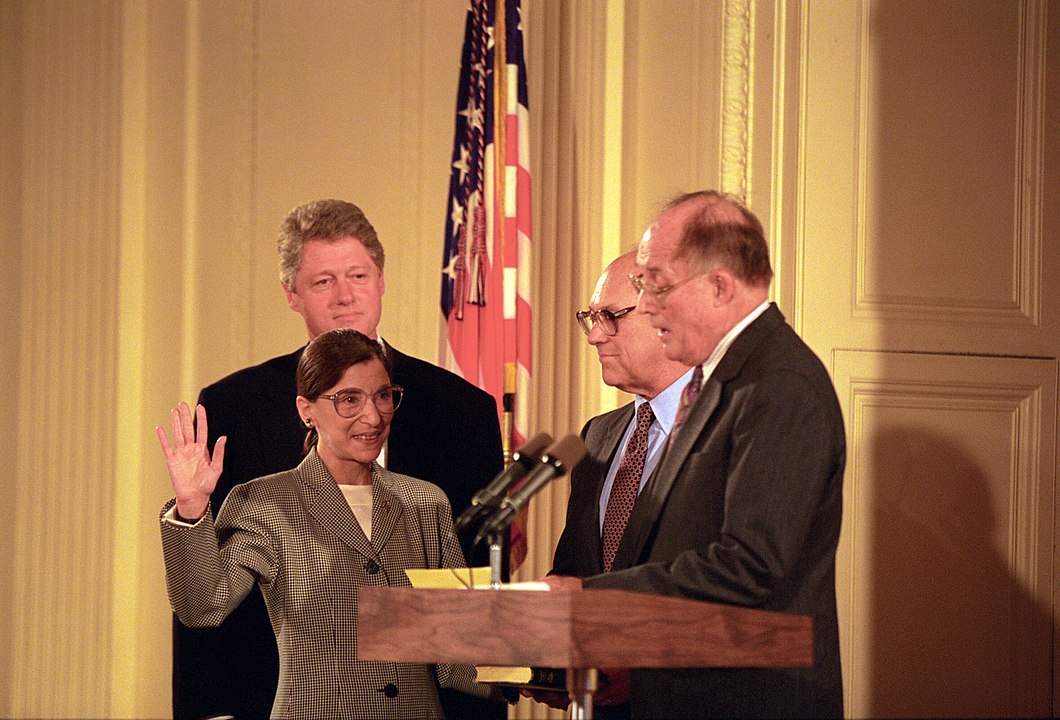

(Chief Justice William Rehnquist swearing in Ginsburg as an Associate Justice of the Supreme Court, as her husband Martin Ginsburg and President Clinton watch; Source: Wikimedia Commons)
Repeated attempts at introducing an Equal Rights Amendment in the US have failed and till today, the country has not signed The Convention on the Elimination of all Forms of Discrimination Against Women or the Convention on Children’s Rights of the UN.
Having chosen her values, the selection of cases she litigated became clear to her. But her strategy to litigate for men was her own. She even chose to represent men seeking equality with women in an attempt to undo stereotypical notions of the gender roles and she succeeded.
One of her early successes was the case of a widower who claimed social security. This was denied to men on the assumption that wives were secondary breadwinners whose incomes were unimportant to the family. This deprived widowers of survivor benefits (Weinberger v. Wiesenfeld, 1975). Linda Greenhouse points out in an article in The New York Times: “In that case, as in several others, the plaintiff was a man. Stephen Wiesenfeld’s wife, Paula, had died in childbirth, and he sought the benefits so he could stay home and raise their child, Jason.” She won the case and began the journey for equal rights for woman under the equal protection amendment, the 14th Amendment.
As a lawyer, this meant her finding a strategy to deal with a Constitution which had no guarantee of non-discrimination based on sex, nor of equality for woman.
It was in 1976 that, for the first time, the US Supreme Court adopted the “strict scrutiny” test for invalidating a law on the 14th Amendment in relation to women. “In a 1976 case, Craig v. Boren, which Ms. Ginsburg worked on but did not personally argue, the Supreme Court for the first time formally adopted the rule that official distinctions based on sex were subject to ‘heightened scrutiny’ from the courts. In that case, the court struck down an Oklahoma law that permitted girls to buy beer at age 18 but required boys to wait until they were 21.”
The test of “strict scrutiny ‘was developed in relation to race but not in relation to sex discrimination. The doctrine required suspect legislation” to be subjected to higher levels of scrutiny to pass constitutional muster, but this doctrine was not used when it came to sex discrimination.
Suspect classification means any classification of groups which suggests that they are likely to be the subject of discrimination. The Indian Constitution mentions the groups likely to be discriminated in Article 15 as caste, religion, sex, race and place of residence. The US Constitution has no such guarantees of non-discrimination based on these suspect criteria. Hence, the Court evolved the test of “strict scrutiny” of all such legislation.
Strict scrutiny is applied to government actions that affect groups that fall under “suspect classification”. Government-sponsored discrimination on the account of a citizen’s race, skin, colour, ethnicity, religion or national origin is almost always unconstitutional, unless it is a compelling, narrowly tailored and temporary piece of legislation dealing with national security, defence, or affirmative action.
RBG went on to perfect this approach in the Supreme Court as a judge when in the Court’s majority opinion in a 1996 discrimination case involving the Virginia Military Institute in Lexington, it held that it was unconstitutional to exclude women from the Institute or to provide them separate facilities on the ground that they were too fragile to undergo the rigorous training required there.
But her strategy to litigate for men was her own. She even chose to represent men seeking equality with women in an attempt to undo stereotypical notions of the gender roles and she succeeded.
“Inherent differences between men and women, we have come to appreciate, remain cause for celebration,” it was held. Focusing her attention on equal opportunity, she said it was “not for the denigration of the members of either sex or for artificial constraints on an individual’s opportunity”. Differential treatment must not “create or perpetuate the legal, social, and economic inferiority of women”. This sums up her philosophy of law.
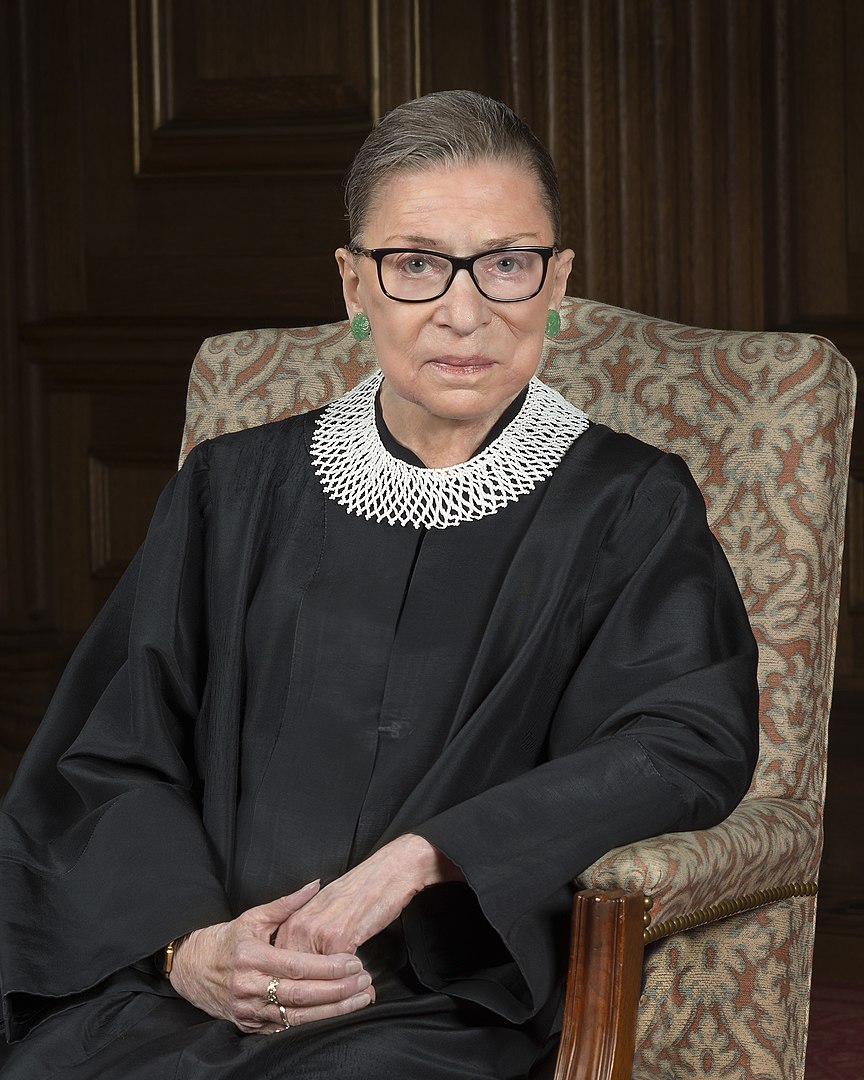

(Ruth Bader Ginsburg, Source: Wikipedia)
Leadership skills
Her success must also have to do with her personality which allowed her to develop a leadership quality to build consensus on issues that destabilised the status quo. No easy task, as we all know, and again I am tempted to say that this is perhaps something only a woman can do.
Surprisingly, however, she believed that the court must not usurp the role of the legislature for more reasons than one. Such an appropriation may, she felt, pre-empt social process and prevent a national consolidation that is brought into existence a new social contract. This, she felt, would prevent polarisation of public opinion on a large scale, defeating the issue.
This was her objection to the 1973 Roe v. Wade decision of the Supreme Court establishing a constitutional right to abortion. In a speech, she criticised the ruling as having “halted a political process that was moving in a reform direction….” It is for this that she was misunderstood as being against the right to abortion rather than being what it was–an opinion that such issues were best left to social process to work out.
The Wade decision did, in fact, result in a backlash, but it was soon realised that the backlash was not spontaneous but engineered by right-wing religionists, something she did not factor in while thinking of political processes. Her ruling in Virginia shows that she would never shy from striking down legislation which was discriminatory on the basis of sex.
One of the most charming episodes of her life is an opera she sang with her colleague, Antonin Scalia, with whom she was in constant disagreement over the power of a court to interpret the law.
Feminist Icon
RBG went on to become an unlikely feminist icon and has been characterised as a first-wave feminist. Those who came after her must surely have built on her body of work. One of the best known among them was Catherin MacKinnon who went on to argue that sexual harassment at the workplace was discrimination based on sex, an argument based on the 14th Amendment and Title VII for equal protection of laws. The strategy was clearly to reinterpret the meaning of “equal protection” as non-discrimination based on sex. MacKinnon went on to argue that equality meant substantive equality judged by the impact policies have on the lives of women and not just formal equality which Ginsburg fought against all her life.
Ginsburg was often described as the “great dissenter”. Dissent too is a necessity when judgments are based on values and as we have seen, Ginsburg had her own consistent value system as a lawyer and a judge. When consensus failed, dissent was the way forward for her. She would read out her dissents in court loud and clear for the general public in an attempt to mobilise public opinion. And yet, she never lost her personal camaraderie with her colleagues with whom she dissented on the Bench.
One of the most charming episodes of her life is an opera she sang with her colleague, Antonin Scalia, with whom she was in constant disagreement over the power of a court to interpret the law. This she did, not only for her love of opera, but she chose a theme on which they both differed, the interpretation of statutes. She believed in what we in India call purposive interpretations, whereas Scalia was a strict interpretationist. The opera was as much an effort to convince her brother judge to her point of view as when she was on the Bench. The full text of the opera is reproduced in the book of her collected writing “In her words”. She was a mix of dignity with a touch of fun and mischief which was reflected in her disarming humour. We see in her how personality and sex influence style in decision-making.
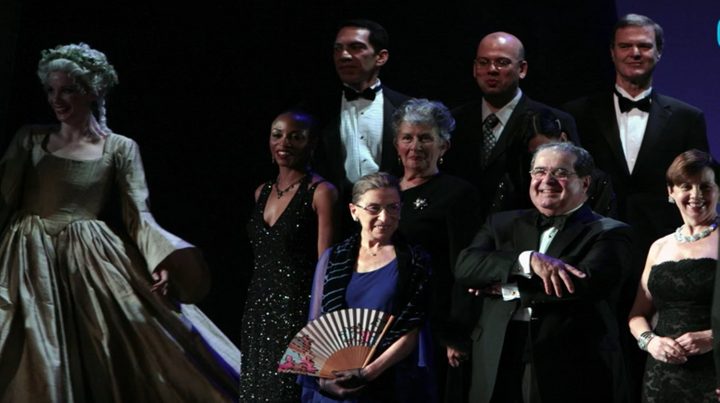

(In 1994, the two appeared as extras in the Washington Opera’s production of Richard Strauss’s “Ariadne auf Naxos.”; Source: Youtube)
Feminist lawyering in India
Ginsburg was a product of her times and her land where she found no guarantee of equality for women in her Constitution. The position under the Indian Constitution is very different. We not only inherited a post-colonial Constitution but also a document that tried to usher in a social revolution. The guarantee of non-discrimination based on sex was a given. We feminist lawyers, midnight’s children, did not have to struggle for formal equality, though substantive equality remains a distant dream. A Ruth Ginsburg was unlikely to emerge in post-colonial India for this reason. Every feminist lawyer has to chart her own career path and make conscious choices about the cases she will argue in the context of her own social and political milieu.
For us in India, equality for women was a gift of the Independence movement and those who came before us fought for it in their own way under colonial rule and later in the Constitution-making process. We got the right to non-discrimination and affirmative action for women in our Constitution. The Indian constitution was a product of a social movement as much as it was for independence from foreign rule.
Justice DY Chandrachud in his separate opinion in Indian Young Lawyers Association v State of Kerala observes:
“74. Reading Dr. Ambedkar compels us to look at the other side of the independence movement. Besides the struggle for independence from the British rule, there was another struggle going on for centuries and which still continues. That struggle has been for social emancipation. It has been the struggle for the replacement of an unequal social order. It has been a fight for undoing historical injustices and for righting fundamental wrongs with fundamental rights. The Constitution of India is the end product of both these struggles. It is the foundational document, which in text and spirit, aims at social transformation namely, the creation and preservation of equal social order. The Constitution represents the aspirations of those, who were denied the basic ingredients of a dignified existence.”
It is this understanding that has fashioned my own feminist lawyering. My early work focused on students and their fight against authoritarian administration, the right to the homeless and the rights of self-employed hawkers, and the right to equality for hostesses of Air India who were denied promotions to supervisory postings based purely on their sex. The issues for me were indivisible; they were social, economic and political. Such an understanding immediately cuts out a path beyond the challenges of formal quality. It also challenges the notion of rights as being negative restraints on the State and brings into the open a discussion on the positive content of fundamental rights.
We had the task of dismantling hierarchies, of gender and caste in the face of formal equality. The main challenge comes from the fight of the right to religion; in the intersectorality between the guaranteed right to religion on the one hand and the right to non-discrimination based on sex on the other hand. In this battle, the right to religion always trumps. Herein lay the feminist challenge for me as a lawyer. Religion is the last frontier that women have to cross in order to dismantle patriarchy in law.
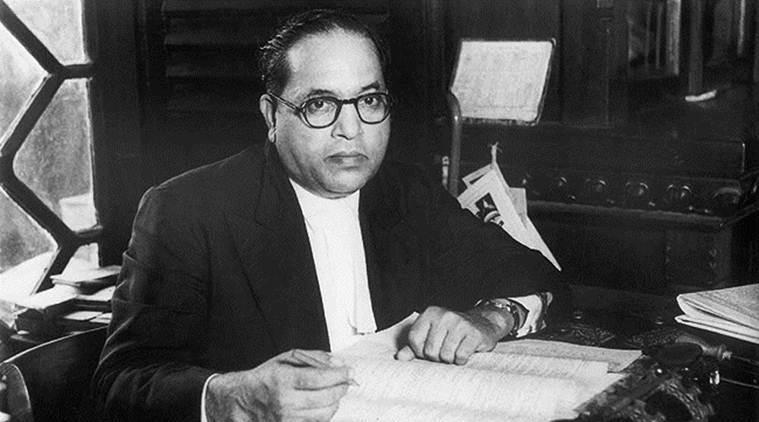

(Dr. B R Ambedkar, Source: Wikipedia)
Case after case challenged the “personal laws” of the community, based as they are on the religion to which we belong. Religious law governs the secular domain, marriage, divorce, child custody, succession, etc. Beginning with Mary Roy where an attempt was made to invalidate a law that gave an inheritance of Rs 5,000 to the daughter and the entire estate to sons, we failed to get a clear-cut judgment for gender equality.
The court held that the Travancore Succession law stood repealed and the more benign and equal Indian Succession Act, which gave an equal inheritance to the daughter and son, would apply. The outcome was a bypass of the main issue that arose for consideration. Later in Githa Hariharian, the court once again dodged a law which declared the father as the natural guardian unconstitutional but held that a mother could also be a natural guardian when the father neglects the child. Both cases did, indeed, spark a social revolution and a debate that continues to this day. In that sense, they served a constitutional purpose.
It was only in Daniel Latifi that the court for the first time said that if the Muslim Women (Protection of Rights on Divorce) Act was not interpreted to mean that it gave “reasonable and fair provision” for life to a divorced Muslim woman, it would be declared unconstitutional. This is the closest that a court has come to recognising equality issues in personal laws.
Our lives are governed by “personal laws” which are based, in turn, on the religion to which we belong. This includes marriage, divorce, child custody and guardianship and in some cases, even the age of marriage is determined by our personal laws. These laws have never been successfully challenged, the fear being that the religious hierarchy of the ruling establishment will be destabilised.
It was only in the Sabrimala judgment that this approach to gender justice was acknowledged. The issue here was the right of women to enter a temple between the age of 10 and 50 when they were menstruating. A futile attempt was made to argue that this was not discrimination based on sex but on age.
The only successful challenge came on the issue of triple talaq, a practice of instant divorce prevalent in the minority community. It was opposed by a government dominated dependent on Hindu support through its attorney general and was called discriminatory and arbitrary. Even then, it was struck down on the ground that it was “manifestly arbitrary”, but not on the ground of non-discrimination based on sex. This is one more case of a just outcome, but one which skirts the issue of a straight conflict between the right to freedom of religion and the right to non-discrimination in the matter or divorce for Muslim women.
It was only in the Sabrimala judgment that this approach to gender justice was acknowledged. The issue here was the right of women to enter a temple between the age of 10 and 50 when they were menstruating. A futile attempt was made to argue that this was not discrimination based on sex but on age. If truth be told, lawyers for the religious hierarchy could not get the word “menstruation” out of their mouth, referring to it instead as “that thing” which happened to women. It is here that our battles as feminist lawyers have been laid and I venture to say, successfully. It is no surprise that there is an attempt to dismantle the Sabrimala judgment by a process of objection by temples. It reminds me of the engendered opposition to Roe v Wade, but the judgment has, thankfully, survived to this day.
A feminist judge in India would have to meet the challenges of secularism to which our Constitution is committed. Among other issues, she would have to deal with the challenge of personal laws, lynching of Muslims, the persecution of minorities under the Unlawful Activities (Prevention) Act and the protection of new minorities, the prisoners of conscience, the dissenters, and those who have the audacity to say NO to an authoritarian majoritarian government.
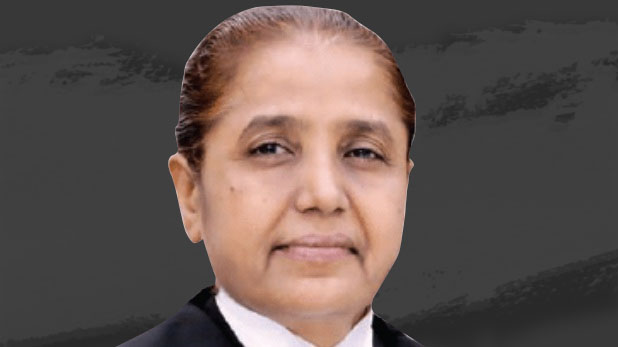

(Justice R Banumathi)
Finally, a Ruth Ginsburg can only emerge in a society governed by the rule of law where all institutions, including the press and the judiciary, do their assigned function without “fear or favour”, as Madhav Khosla pointed out in a recent article in NYT Judiciaries in Turkey, Hungary, Poland and India have collapsed in the face of majority governments. Our press has come to be described as the “Godi press”. Contempt of court is now thrown at us by the courts for standing up for our rights. The very right to legal representation is under threat. Where then does one even begin to talk of an Indian Ruth Ginsburg?
An unfortunate instance of a woman judge failing to recognise an equality issue under her nose comes to mind. Recently, retired Justice R Banumathi was appointed to head a commission of inquiry under the Judges Inquiry Act. At issue was whether a woman district court judge was sexually harassed by a sitting judge of a High Court, a first in Indian legal history. Extensive evidence of sexual harassment was led with the woman judge subjecting herself to cross-examination. The evidence was clearly against the judge accused of sexual harassment. The committee posed the question: “What is the standard of proof required to prove sexual harassment?” The conclusion was–“beyond reasonable doubt”. A woman judge, no feminist I would say, failed to see that sexual harassment was a constitutional wrong, apart from being a crime and what was at stake was the right to equality before the law and equal protection before law, not prosecution for a crime.
Our women judges have not left a legacy of judgments which strengthen equality before law and non-discrimination based on sex.
The woman judge in question argued that she has been transferred out of her jurisdiction mid-term as an act of victimisation for refusing the advances of the judge who was also her supervisor. She demonstrated that the transfer was contrary to rules which said that a woman judge should not be transferred if she has a daughter in Class X doing a board exam. Her request being denied, she had no option but to resign. Here was a working woman forced to choose between her career and her duty to her child, a choice she ought not to have been confronted with under the law. Justice Banumati failed to see the link between the antecedent sexual harassment and the subsequent transfer. A Ruth Ginsburg, on the other hand, would have seen the link as clear as daylight. And yet we have has a male judge who on his retirement said “I think I am a feminist”. That was Justice Sikri.
Our women judges have not left a legacy of judgments which strengthen equality before law and non-discrimination based on sex. Perhaps Justice Sujata Manohar, an otherwise conservative judge, could be said to have done so in Vishakha, where a beginning was made based on the work of Catherin Mackinnon in this regard.
But a Ruth Ginsburg can only emerge in a society governed by the rule of law. India is no longer a society governed by the rule of law. Our press is described as the “Godi press”, our courts have lost their thirst for justice as it evident from the fact that they put in cold storage cases of constitutional importance relating to life and liberty, while lawyers are condemned to face contempt of court charges. Our youth are thrown into prison on charges of “terrorism” for attempting to destabilise the nation by protesting against the Citizenship Amendment Act. An overzealous police force abuses the process of investigation and converts us into criminals, guilty and deprived of liberty until proven innocent. Unless the rule of law is first restored, there is no likelihood of a Ginsburg emerging from the Bench of the Supreme Court of India.
(Indira Jaising is a Senior Advocate and human rights activist. Views are personal.)


